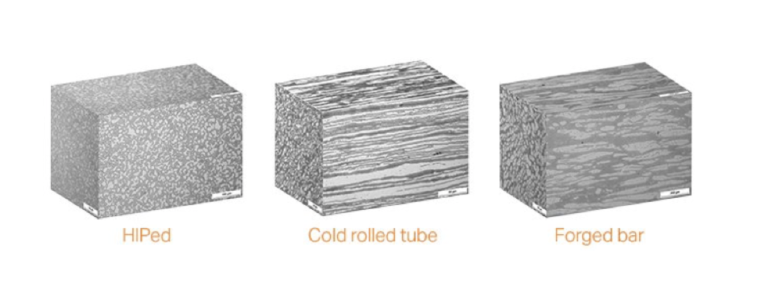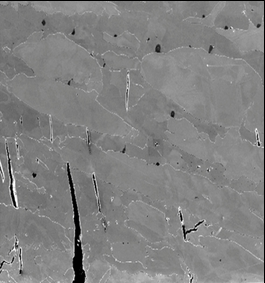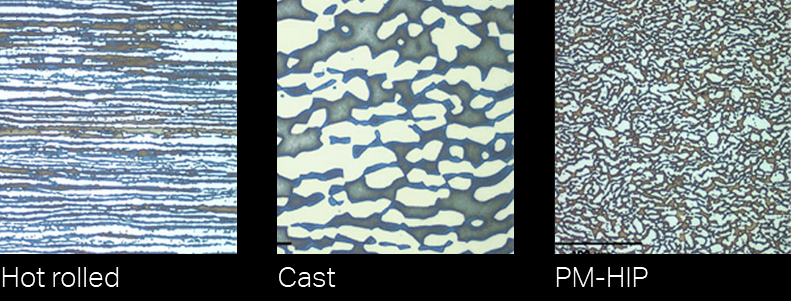Get product reliability in every detail
There’s no room for compromise if you’re designing parts in complex geometries that must perform at low or high temperatures and handle stress in aggressive environments. The beauty of HIPed products is that you get a dense, uniform material with a super-clean microstructure and equal strength in all directions (isotropic). Note the difference here between the HIPed microstructure compared to cold-rolled tube and forged bar (below):

New possibilities for compound solutions
Can’t find a material that works in all areas of a component? Do you need multi-material parts? Are you using weld overlays? If so, the HIP process is an economical way to use a high-alloy materials to create the entire component or only in the areas where the component is exposed to harsh environments. For example, you might want to combine corrosion-resistant materials in one area of a part with high wear resistance in a second area.
This could also involve adding a high alloyed powder layer on a more economical metal substrate or even using multiple materials. With HIP, you get a high-performance alternative to conventional overlaying like PTA cladding, welding or brazing. MTC has successfully manufactured parts with up to four materials, but there is no limit to the number of materials that can be used in a single part.
Reduce hydrogen-induced stress cracking (HISC)
Even the strongest component in forged or cast duplex stainless steel can become brittle and facture following exposure to high stress in a disadvantageous design. This is caused by a coarse microstructure which – in combination with high stress and pressure – facilitates the ingress of atomic hydrogen into the metal at the steel surface. See example below:

Hydrogen diffuses much more easily into the ferritic phase of duplex stainless steel, which contains both ferrite and austenite in roughly equal proportions. HIPed products drastically reduce this problem due to their fine microstructure. The low austenite spacing (typically <15 μm) limits how far hydrogen can diffuse into the material before reaching the austenite phase, which drastically slows down this process. As a result, hydrogen is unable to penetrate as far into the material and cause as much or deep embrittlement, as in a conventional material. In the oil and gas industry, steel materials with an austenite spacing of less than 30µm are considered fine grained (DNV RP F-112), meaning they have a higher allowable stress. HIP Duplex Stainless Steels is below 15µm.
Avoiding anisotropy
Hot-worked steels, such as forged or hot-rolled steel, have an elongated grain structure that is unequal in all directions (i.e. anisotropic). This means they are also weaker and more brittle when force is applied perpendicularly versus along the grain structure – a drawback for components exposed to high physical-mechanical stress. In contrast, HIPed materials are dense, uniform and isotropic, meaning that you get an even level of strength in all directions – one that is equal to or better than hot-worked materials in their best direction.

Above you can see the differences in microstructure between standard hot-rolled steel (left) and cast steel (middle), compared with the fine isotropic microstructure of super-duplex stainless steel (right). The use of HIPed powder material in our family of duplex stainless steel grades provides an improved design advantage over traditional thick-walled forged or cast infrastructure.
Corrosion resistance
Whether you are designing a valve body, fuel nozzle or another component that will be exposed to chlorides, hydrogen sulfide or other aggressive environments, we can help. For more than 50 years, we’ve supported the oil and gas, aerospace, mining, nuclear and other demanding industries with our expertise on wet corrosion,high-temperature corrosion and wear. We stock a wide range of duplex, super-duplex and nickel alloy powders that offer excellent corrosion resistance. Our metallurgical experts have also developed a number of proprietary powders for especially tough conditions. Just let us know what you’re up against.